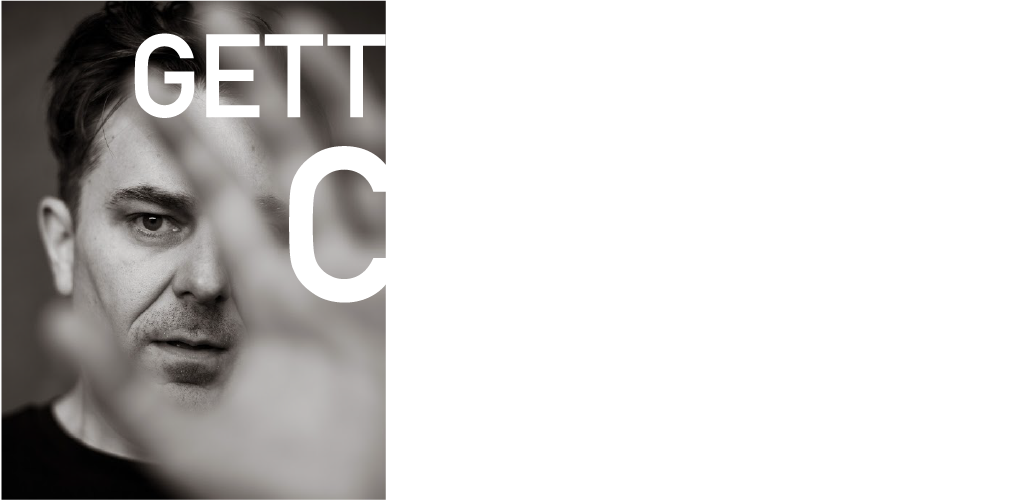Robert Scott Smith in promotional photo for Sackerson’s “A Brief Waltz in a Little Room: 23 Short Plays About Walter Eyer.” (Photo: Ashley Thalman at Ultraviolet Studios)
We know what we’re doing when we go to see art. As spectators, traditional formats for arts experiences have set inherent expectations for us. Theatre and dance-goers know how to buy a ticket, take a seat, and silence cell phones before the house lights go dim and the curtain is drawn. At galleries and museums, visitors speak in hushed voices, and hold their hands safely at their sides or back: look, don’t touch. For as long as we can remember, we have sat before screens, gazed upon stages, and strolled along spacious exhibition walls. Typically, not much is asked of us but to be there. Some of us like this arrangement and, undoubtedly, art presented this way has moved us for centuries. But can we get closer?
Lately, Utah creatives across mediums are asking this question. In the digital age, where attention is a commodity, it takes more to jolt our systems. Boldly and experimentally, artists are leaning into a rising sense that local audiences are ready, and maybe even ravenous, to burst beyond traditional expectations around performance and exhibition. Hungry to affect art as they are affected by it, viewers welcome opportunities to be fully immersed, perhaps surprised, perhaps changed.
This year, as University of Utah artmakers blew the rules wide open, they made profound connections with audiences, inspired fresh conversations with students, and made arts lovers out of a new and unexpected crowd.
Audience as protagonist
Immersive theatre deepens the audience-to-performer relationship by pushing boundaries through proximity and interaction, and heightens viewer autonomy by allowing for choice and free movement through spaces. At times, immersive theatre can feel so close you wonder if it was made only for you.
“A Brief Waltz in a Little Room: 23 Short Plays About Walter Eyer,” produced by local theatre company Sackerson this past fall, took audience members, one at a time and with headphones on, through scenes unfurling the life of one man. In the back rooms of the Gateway Shopping Center’s Urban Arts Gallery, each patron became Walter Eyer, stepping into his world, hearing his voice in their own heads, brushing up against his closest relationships, feeling his heaviest burdens. Many creative alumni and faculty of the College of Fine Arts collaborated with Sackerson to bring the show to fruition.
By making the audience member the lead protagonist, Sackerson removed the leading actor from the live experience. But although he did not perform live, Assistant Professor at the University of Utah’s Department of Theatre, Robert Scott Smith, embodied Walter for the show’s video projections, sound, and imagery. Smith was fully on board.
“It is really in line with what I strive for, in thinking about how to get out of the constructs of narrative and innovative ways to be part of the art,” he said. When he attended the show as a spectator, and was thrown back into relationship with the very character he developed, he described the unconventional experience as “meta.”
No two audience members saw the same production, as each experienced the 20+ available scenes in a random order. In this way, the production mimics the truly voyeuristic and fleeting quality of the human experience.
“There is a part of you that always wants more of the story. But based on what you choose to explore and become invested in, your path is your own,” Smith said.
Sackerson has been creating unconventional works that rekindle the audience’s role in live theatre since 2015. Incorporating site-specific design and intimate storytelling, their productions have captured the interest of a unique demographic and laid the groundwork for this burgeoning genre to rise in Utah.
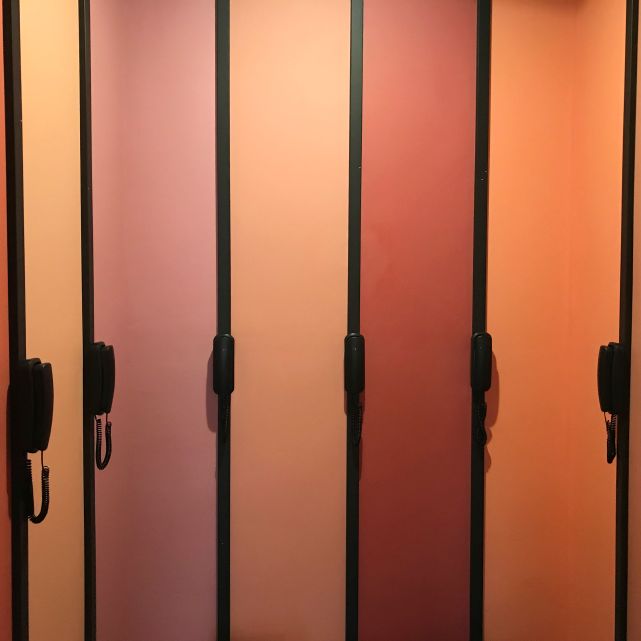

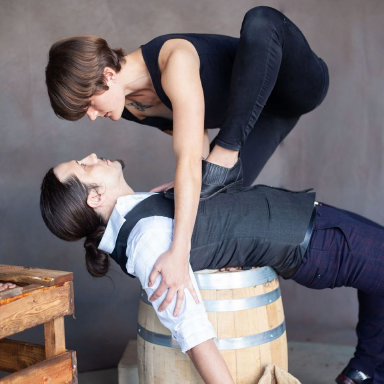
Performers Michael Watkiss and Lauren Payne in promotional photo for SONDERimmersive’s “Thank You Theobromine” (now newly titled “The Chocolatier”). (Photo: Ashley Thalman at Ultraviolet Studios)
One room in “A Brief Waltz in a Little Room: 23 Short Plays About Walter Eyer,” designed by Dan Evans.
Space as muse
In proscenium works, the audience only views the set frontally, and from the distance of the house. In immersive work, the audience can touch, smell, and feel all elements of a scene, requiring that every inch be designed so as not to break the story’s spell. Another key factor is audience routing. It is imperative that the audience is cared for, ushered in a way where they can confidently give in to the experience, but boundaries and limitations are clear.
Design is paramount in materializing the worlds of immersive theatre. Designers evoke specific emotions for scenes, mask and integrate technical elements, and move audiences efficiently and responsibly.
Often the initial muse for the script, the space becomes a continual partner in guiding an audience’s trajectory through a story’s arc, and so finding the perfect venue is often the starting point. Dan Evans, Associate Professor in the Department of Art & Art History, has a wealth of experience in designing for performance, as well as creating environmental graphics and exhibition design. Evans collaborated for many years with LA-based choreographer Heidi Duckler, who worked very much in the site-specific immersive vein, transforming numerous blank sites into vivid worlds for performers to inhabit.
“As a visual designer, this is how I already naturally approach the world. I’m drawn to pieces that invite interpretation. And to me, working collaboratively with directors and artists across mediums is the best way,” Evans said.
Most recently, he was one of the designers Sackerson enlisted to create the world of “Brief Waltz.”
As opposed to rooms with more straightforward scenic needs, Evans was most interested in rooms with the greatest number of question marks: he was tasked to create the setting for a scene of conversion therapy, the now discredited practice of attempting to change a person’s sexual orientation or gender identity (for which he incorporated bright, oppressive lighting and imagery that would heighten claustrophobic feelings) and a second room inspired by “an impossible game of twister.” Unlike the tight install and strike schedules of typical touring shows, Sackerson gave the team ample time to work independently in the space.
“There was immersion in the design process as well,” Evans said. “I love working in reality. Having that giant workshop to play in is a luxury.”
Up close and personal
This firm belief of School of Dance alumnus Graham Brown drives a pressing desire to blend dance, narrative, and audience proximity.
Brown’s latest project, “Thank You Theobromine,” is an immersive dance theatre production that takes place inside a multi-level working chocolate factory in downtown Salt Lake City, the Chocolate Conspiracy. Like in “A Brief Waltz in a Little Room,” guests experience intimate proximity to performers, perhaps close enough to hear a whisper, or be invited to join a slow dance. Co-directed by Brown and Rick Curtiss, and produced by their company SONDERimmersive, the show explores ambition, love, and loss through the multiple sides of one chocolatier.
Brown has been hooked on narrative performance for many years. Since discovering the work of UK-based physical theatre company DV8, whose acclaimed work incorporates dance with film, theatre, and text, Brown became “enamored with really saying something, with making work where the audience is invested in what happens next in the story.”
To this end, his graduate work focused entirely on the integration of dance and theatre. Later, he encountered “Then She Fell” in NYC, an immersive dance theatre work that completely removed the proscenium and allowed the audience to roam free through winding spaces. “I was drawn to the clarity of content, the intentionality, the proximity...there is an infectiousness to this kind of work. There is an enormous capacity to get lost in it.”
One of “Thank You Theobromine’s” original performers was Department of Theatre Professor Sarah Shippobotham, whose acting expertise was key in integrating the story with movement. Because the diverse cast brought a range of different perspectives and strengths, collaboration amongst artists was key. In breaking down traditional hierarchies, designers, writers, and performers could find synergy in the evolution of a production.
Brown has noticed that the crowd showing up to immersive performances includes new faces outside of the community that frequents Utah dance. The intrigue of the unknown continues to draw out new arts enthusiasts.

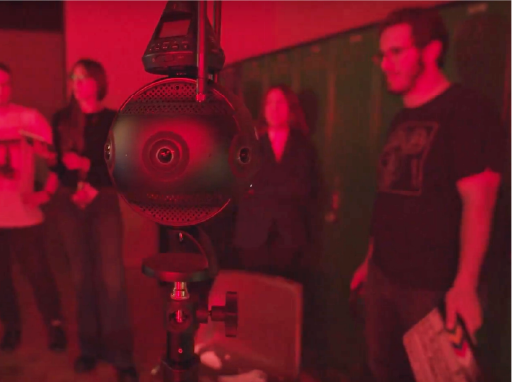
(Left to right) Student Harrison Greene, Assistant Professor Sonia Albert-Sobrino, and Graduate Student Elizabeth Lowe during a Grip and Lighting class working with the Insta360 Pro 2 Spherical VR Camera. (Photo: Jack Houghton)
Surrounded on all sides
In good filmmaking, the story alone is often enough to make us lose ourselves. In recent years, strides forward in virtual reality (VR) technologies and 360-degree cameras have expanded possibilities in film and media, calling for new methods in the studio.
“There is no doubt new technologies are changing the way we experience film and media,” said Ha Na Lee, Assistant Professor in the Department of Film & Media Arts. “Will VR cinema ever overtake single channel 2D formats, or will it be relegated to the fringes of filmmaking? New media formats such as VR are still largely experimental and auteurs are grappling with a new visual language, new freedoms, and new constraints. The technology is still nascent, but improving rapidly.”
As students from the University of Utah prepare for careers in moving images, it is imperative that they are not only exposed to emerging technology but that they develop an adaptive mindset, ready to consistently evolve with cutting-edge tools as they are introduced.
Assistant Professors Miriam and Sonia Albert-Sobrino are keenly invested in students being prepared professionally in this way. The sisters were awarded a University Teaching Grant in Spring 2019 allowing the Department of Film & Media Arts to purchase an Insta360 Pro II Spherical VR Camera. This past fall, Miriam’s Grips & Lighting Course incorporated this camera, challenging students to script, light, design, and film their work in new ways.
“It’s a perfect learning scenario for Grips & Lighting,” she explained. “Since we are filming all around the camera, hiding the lighting equipment becomes more challenging. The visual effects route, while very possible, can be both tedious and expensive, so it becomes really important to approach the project efficiently using professional practical lighting and collaborating with the production designer to conceal film gear on set.”
Working in collaboration, the class wrote a comedic horror script in which characters are struggling to put a disconnected head back on its body. All shots addressed the central camera as if it were this lost head, putting the viewer at the center of the chaos.
To write for the six planes of action, the class used a color-coded scripting system.
They shot their scenes in a freight elevator, hiding lights behind the props. Special attention was paid to the movement of the camera to limit a viewer’s dizziness while still surrounding them with action on all sides, and not allowing lenses to capture overlap.
Film student Braden Ingraham played the main character in the film. “I found it very hard to act in such a tight space as to not get into other camera lenses,” he said. “It felt unnatural to act in the environment, interacting with a small camera as a person. It helped me grow a lot as an actor.”
Sonia also incorporated the Insta360 Pro II into her Digital Cinematography class, but with a special focus on its idiosyncrasies for Digital Cinematographers.
“As filmmakers we must keep up with the constantly-changing technology, and that obviously includes professional 360 cameras,” she said. “In the classroom, we devote as much time as we can to 360 technology, but we do so from the cinematographer’s standpoint. The students learn the peculiarities of these more advanced cameras and are looking at focus distance, camera exposure, clean plating, and the more complex post-production workflows.
Film & Media Arts students are introduced to virtual reality early in their training at the U. Lee introduces it along with projection mapping in Intro to Media Production, a class designed to explore multidisciplinary art practices with emphasis on extending the moving image beyond conventional production and screens. Once students reach advanced levels, they work with multi-channel video, and interactive and algorithmic techniques for viewing video.
“Students should explore expanded cinema and extend their creativity beyond traditional screen-based filmmaking. As creative artists and filmmakers, it is important to experiment with and understand the strengths, weaknesses, and unique characteristics afforded by emergent media,” Lee said.
Furthermore, Lee is developing a Media Arts Department (MAD) lab, which is a creative space dedicated to teaching and research around emerging and experimental filmmaking for people in the Department of Film & Media Arts. “The lab has a capacity to support contemporary cinematic installations, performances, multi-channel films, VR, 4K video, volumetric filmmaking, ambisonic sound, projection mapping, and physical computing for interactivity,” she said.
Despite expanding possibilities, Lee doubts traditional filmmaking is going anywhere.
“It’s not a zero-sum game,” she said. “When online streaming services such as Netflix, Amazon, Hulu became popular, many people predicted the end of traditional cinema. However, both platforms still coexist. In my opinion, VR won’t replace our regular film experience, but it is the beginning of a more individualized interactive embodied experience — apart from the collective experience of the movie theater.”
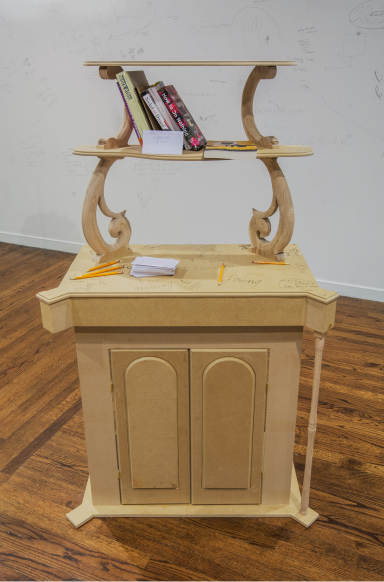
Part of “Never An Hour for Thought” by Kelsey Harrison at UMOCA. (Photo courtesy of UMOCA)
Connection over product
Assistant Professor Kelsey Harrison declined to write a press release for her UMOCA exhibition, “Never An Hour For Thought.” Not only was summarizing her work for consumption counterintuitive to her ongoing process and the fundamental underlying themes of the work, it was the very thing she was questioning.
“I don’t have the conclusions,” she said. “I invite people to think about these things with me.”
In a churning market for creatives, societal pressures to produce, market, and move on can create isolation over connection. Harrison’s artistic practice at this particular moment in her career called for questions over answers. It called her to observe more than to instruct, to leave things open ended rather than perfectly punctuated, to create space for interaction over exhibition.
“People like to make art that makes them smart, and people like to see and understand art because it makes them feel smart,” Harrison said. For the work, she filled a hallway with vinyl cutouts of tropes she had subverted through rewriting such as: “Life is about Peace, Peace is Surrender, Never Give Up.”
“The hallway was ‘here’s where we’ll be smart together,’” she said.
Turning the corner, things change. A spacious room holds a couple of original furniture pieces, and stacks of carefully selected books. As she observed viewers, no one would quite relax into the space as she had hoped, to take the time to read the selected books or use the space to be.
Experiements in Listening and Talking
Sound recording of Harrison’s show at UMOCA, Recording by: Emeri Fetzer
But perhaps shaping an event to foster an experience could change the approach. To this end, Harrison hosted two live events within the exhibition space at UMOCA bringing live music, performance, and discussion into the gallery space. On night one, experimental music duo Red Desert, with percussionist Devin Maxwell and clarinetist Katie Porter, performed on and around the furniture.
“I like how experimental music changed the relationship to attention. There are often quite grating sounds, or elongated silence. As opposed to pop music where you follow a programmed experience, this kind of sound doesn’t just wash over you.” Seated on the chaise lounge she designed, Harrison read “Exhaustion and Exuberance,” an essay by Jan Verwoert suggesting the idea of care as a way to subvert the pressure of a high-performance society.
For the second event, entitled “Experiments in Listening and Talking,” Harrison invited composer Phillip Bimstein to share his own music and lead those gathered in some tonal experiments developed by sound artist Pauline Oliveros. Harrison and Bimstein finished the evening with a dialogue of passages from their selected readings.
In offering a space for engagement, Harrison expanded the exhibition experience beyond mere observation, allowing visitors to become part of the underlying questions, and therefore part of the artmaking. Perhaps, investing in community is her way of slowing down the production machine. Either way, this care is felt long after the exhibition comes down.
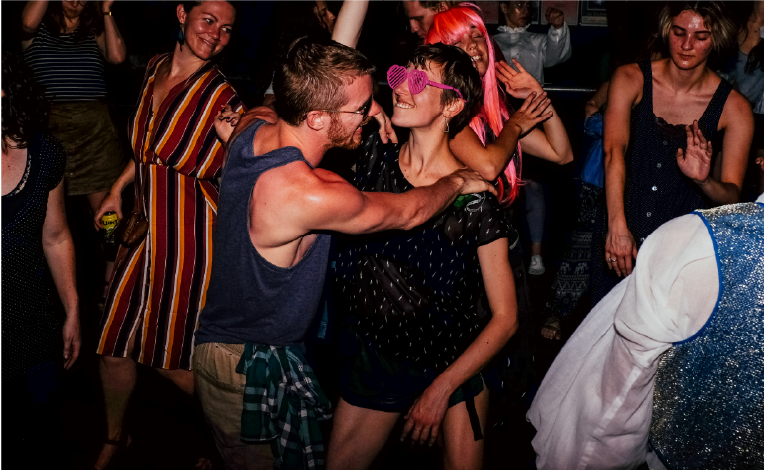
Dancers at Heartland Collective’s Valentine’s Day performance turned dance party. (Photo: Tori Duhaime)
Freedom is a Dance Party
Associate Professor in the School of Dance and Director of Heartland Collective, Molly Heller is discovering new possibilities at the intersection of dance performance, community, and wellness. “The pairing of a performance that merges into a dance party, attempts to dismantle the hierarchy of the performer/audience relationship and gives autonomy to participants, where they have freedom to engage in any capacity and enter and exit the event,” Heller explained.
If you attend a Heartland performance, you are likely to find yourself on the dance floor with performers before the evening is complete.
Born from a desire to cultivate connection alongside others through movement, Heartland Collective designs movement around the language of the heart, incorporating fantastical themes like Valentine’s Day, woodland creatures, or the cosmos. Heartland performances culminate in dance parties that invite audience members to dive deep into their own bodies and process their emotions, much like you might do in a dance club.
“The pairing of a performance that merges into a dance party, attempts to dismantle the hierarchy of the performer/audience relationship and gives autonomy to participants, where they have freedom to engage in any capacity and enter and exit the event,” Heller explained.
“The curation of an evening that manifests within the choreography, scenic design, costuming, and music, is intended to be a platform to build trust and care with an audience,” Heller said. “Our mission within the performances + dance parties is to cultivate a sense of belonging and to co-create an experience alongside an audience. As our themes navigate emotional complexities, the body gets to process its responses through movement. Our intention is to share the inter-workings and intra-workings of the heart in the company of others, risk, and embrace imagination.”
Beyond integrating performers and viewers, Heller is also interested in bringing dance to unexpected places and in allowing performances to roam. Experimenting with a pop-up format, Heartland has locomoted audiences through downtown Salt Lake City, from north to south Main Street.
“The idea of a moving performance is not necessarily unexpected, but what occurs within this approach will always be unexpected and unpredictable. It also allows us to work in public spaces where people find our work who might not typically engage with dance,” she said. ■
In a time where we are more likely to connect over social media, with less opportunities to engage in physical closeness with both strangers and those we know, immersive art is giving us the space to take a chance, to let ourselves be seen. Through challenging local audiences, these remarkable artists within the College of Fine Arts community are expanding and extending the meaning of their work. Whether it is confiding to an audience member in a closed room, welcoming a new dialogue, letting loose on the dance floor, or curating a space that sparks the imagination, these artists refresh known formats and battle disconnect. With unwavering belief in the transformative power of art experienced live, they push Utah into the next wave of arts engagement, putting our growing city on the map for innovation and enthusiasm.








